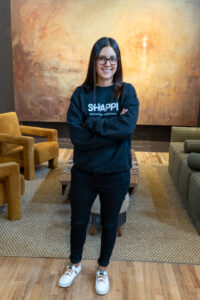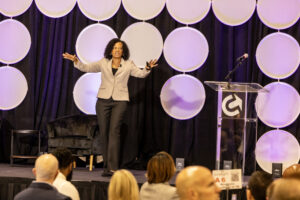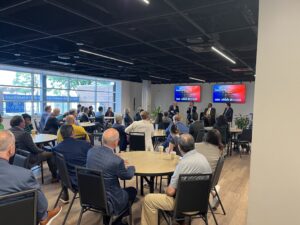Emily Turner, Spaeth Communications
As a public speaker and coach, I frequently poll the audience to see who is familiar with TED Talks. It’s probably no surprise that in 2018, the affirmative response rate to my unofficial poll hovers around 95 percent. Just a few short years ago, audiences had to be introduced to these entertaining and informative presentations. Now, it’s the quality audiences expect for everything from a finance presentation to an Instagram story.
We’re convinced that in the professional world, you can cover technical material and still make it memorable. At Spaeth Communications, our brand of presentation skills training relies heavily on real-world short video clips showcasing presenters doing a good job (as well as those who need improvement). TED Talks have given us a motherload of good examples and — not surprisingly — back up our methodology. We have been spreading the word for over 30 years now that people don’t listen as groups, they listen as individuals. The best speakers know this and hone in on the power of storytelling and name the audience. They use props, innovative visual aids and are careful to put numbers into context.
Here is a breakdown of what goes into a successful performance and how you can make the most of your next opportunity.

Tell a Story
Brené Brown, Ph.D., delivered one of the most-watched TED Talks of all time and her performance rocketed her into the stratosphere of popularity. As a researcher and professor at the University of Houston Graduate College of Social Work, she often describes herself as a “reluctant storyteller,” as if the entire concept was contrary to being respected in academia. The result couldn’t have been further from the truth. Brown is the author of four no.1 New York Times bestsellers that all share the common thread of presenting her research via various relatable stories. The best stories have dialogue, action, resolution and are delivered conversationally.
Engage the audience
Bill Gates captured his audience’s attention by releasing live mosquitoes during his talk about eradicating malaria (spoiler alert — they weren’t infected with the virus), while Hans Rosling, Ph.D., used different colored plastic boxes from IKEA to make his point about population growth come to life. In addition to props, TED presenters use only the most powerful visual aids and traditional PowerPoint slide decks are forbidden. President Obama used our favorite prop, an iPad, when showcasing U.S. cities and world capitals that had invested in high-speed Internet infrastructures. It’s also our favorite example because Chattanooga was one of the cities he highlighted during this video update.
Make Time to Rehearse
Meeting planners regularly hire us to coach their speakers. Audiences are much more receptive to short, 20-minute presentations than hour-long panels. Our audiences’ attentions are pulled in more directions than ever before in history. However, preparing speakers for these events is no small task. We work with one client to prepare two speakers at a time each quarter to deliver their “Advanced Knowledge Sessions,” or their version of TED Talks, at their conferences. The speakers participate in an initial day of Spaeth training and then the team gets to work perfecting the material, ensuring the visuals are minimal and memorable and most importantly — finding the right balance between storytelling and educational information developed for that specific audience. To date, the most inspiring speakers have been the ones who dedicated the time to rehearsal and memorized their 20-minute presentations. Sure, we have confidence monitors that hover at their feet and some chose to use an iPad as a teleprompter, but for those who won a standing ovation, memorization was the name of the game.
I promise that these methods engage the audience and are guaranteed to make you more memorable. Are you ready to take your performance to the next level?







